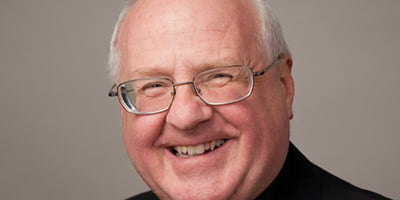
Father Mark Goldasich is the pastor of Sacred Heart parish in Tonganoxie. he has been editor of the Leaven since 1989.
by Father Mark Goldasich
I’m not sure if it was an old-fashioned incandescent or a newer, energy-efficient LED. But what I do know for sure is that a light bulb (or two) definitely went on over my head a couple of weeks ago.
It all started on Oct. 19, when the church celebrates the feast of Fathers John de Brébeuf and Isaac Jogues and their companions, more popularly known as the North American martyrs. Most Catholic schoolchildren of a certain age grew up on the stories of these valiant Frenchmen of the mid-17th- century who endured horrible tortures to bring the Gospel to the Huron and Iroquois people.
My first glimmer of insight came from a commentary by Father John Petrikovic, OFM Cap., in St. Anthony Messenger’s Weekday Homily Helps on the Mass readings for that day. Father John noted that there’s a real fascination today among young people with “blood and guts and gore” as depicted
in various vampire movies and novels. On the surface, these vampires are quite seductive, but it’s just a mask that hides their “beastly interiors.” Eventually,
the vampires lead people to an eternal death, “where they can never cross the border to real eternity.” The blood of the martyrs, on the other hand, leads people instead to eternal life.
I was still pondering Father John’s insights when a second glimmer of insight hit me. An article in the Nov. 1 issue of Bottom Line/Personal newsletter, entitled “Mind Games: Why We Don’t See What’s Right In Front of Our Faces And Other Ways Our Brains Fool Us,” told of a study done by two professors — Drs. Christopher Chabris and Daniel Simons — when they were at Harvard University. They conducted what’s become known as the “gorilla experiment.” In a nutshell, these two professors asked volunteers to watch a videotape of a basketball game and count the number of times the ball was passed. People were so focused on the counting that “approximately half of them failed to notice a person in a gorilla suit walking right across the screen.” The experiment showed that our mind can edit things and “not always observe, remember and reason as well as we would like to think it does.”
Zap! On came the light bulb.
Is it just me, or does it seem like Halloween becomes a bigger and bigger deal every year? You can’t turn on a TV these days without seeing some “fright night” marathon or episodes of favorite shows featuring a spooky theme. It’s like Father John observed earlier: We seem stuck in the “eternal death” mode, but forget all about eternal life.
Halloween, as I’m sure you know, comes from the old name for the eve of All Saints. “Hallow” is another word for “saint,” and so it was originally known as All Hallows Eve(ning), which got shortened to Hallowe’en. And that’s where the “gorilla experiment” comes in for me: We are so focused on the “eve” part — the spooky, frightening, eerie aspect — that we don’t even notice the “hallows,” the saints. It’s as if we come right up to the door, if you will, but never enter to enjoy the real celebration.
And make no mistake about it, the saints are there for us to celebrate . . . and imitate. They are folks just like us who show what powerful things God can do when we let him work through us. They are a mixed bag of people— women and men, young and old, famous and not-so-famous, of all times and places. In what we call the “communion of saints,” they not only live in God’s presence, but pray for us and are ready to help us… if we call on them.
As Christians today, we’re challenged to move people from being fascinated with vampires, who don’t really exist, to getting familiar with the saints, who really do. A first step might be to rediscover the saints for ourselves.
An easy place to start is with “Voices of the Saints” by Bert Ghezzi (Chicago: Loyola Press, 2000; 789 pgs.; $19.95). Don’t let the number of pages put you off. The subtitle of the book clarifies things: “A 365-Day Journey With Our Spiritual Companions.” Each daily entry is only a couple of pages long
and includes a short biography of the saint being featured, a sample of that person’s writing, his or her feast day, and what the saint is the patron of. The book goes from the Blessed Mother all the way to Mother Teresa. Even though there are wonderful indexes in the back (by theme or name or calendar date), I recommend going through the book in order, day by day, to get a taste of the variety of people God has chosen to bring his light to the world.
Who knows? Maybe one of these stories will trigger a light bulb of inspiration in your heart and help you to shine brightly in our world, leading people from the spookiness of Halloween into the holiness of All Saints.


